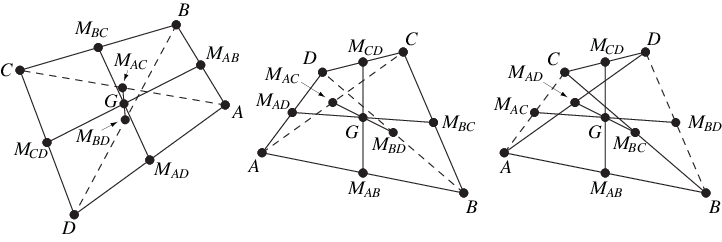A quadrilateral, sometimes also known as a tetragon or quadrangle (Johnson 1929, p. 61) is a four-sided polygon. If not explicitly stated, all four polygon vertices are generally taken to lie in a plane. (If the points do not lie in a plane, the quadrilateral is called a skew quadrilateral.) There are three topological types of quadrilaterals (Wenninger 1983, p. 50): convex quadrilaterals (left figure), concave quadrilaterals (middle figure), and crossed quadrilaterals (or butterflies, or bow-ties; right figure).
A quadrilateral with two sides parallel is called a trapezoid, whereas a quadrilateral with opposite pairs of sides parallel is called a parallelogram.
For a planar convex quadrilateral (left figure above), let the lengths of the sides be ,
,
,
and
,
the semiperimeter
, and the polygon diagonals
and
. The polygon diagonals
are perpendicular iff
.
An equation for the sum of the squares of side lengths is
|
(1)
|
where
is the length of the line joining the midpoints of the
polygon diagonals (Casey 1888, p. 22).
For bicentric quadrilaterals, the circumcircle and incircle satisfy
|
(2)
|
where
is the circumradius,
in the inradius, and
is the separation of centers.
Given any five points in the plane in general position, four will form a convex quadrilateral. This result is a special case of the so-called happy end problem (Hoffman 1998, pp. 74-78).
There is a beautiful formula for the area of a planar convex quadrilateral in terms of the vectors corresponding to its two diagonals. Represent the sides of the quadrilateral
by the vectors ,
,
, and
arranged such that
and the diagonals by the vectors
and
arranged so that
and
. Then
|
(3)
| |||
|
(4)
|
where
is the determinant and
is a two-dimensional cross
product.
There are a number of beautiful formulas for the area of a planar convex quadrilateral in terms of the side and diagonal lengths, including
|
(5)
| |||
|
(6)
|
(Beyer 1987, p. 123), Bretschneider's formula
|
(7)
| |||
|
(8)
|
(Coolidge 1939; Ivanoff 1960; Beyer 1987, p. 123) where is the semiperimeter, and
the beautiful formula
|
(9)
|
(Bretschneider 1842; Strehlke 1842; Coolidge 1939; Beyer 1987, p. 123).

The centroid of the vertices of a quadrilateral occurs at the point of intersection of the bimedians (i.e., the lines and
joining pairs of opposite midpoints)
(Honsberger 1995, pp. 36-37). In addition, it is the midpoint
of the line
connecting the midpoints of the diagonals
and
(Honsberger 1995, pp. 39-40).
The four angle bisectors of a quadrilateral intersect adjacent bisectors in four concyclic points (Honsberger 1995, p. 35).
Any non-self-intersecting quadrilateral tiles the plane.
There is a relationship between the six distances ,
,
,
,
, and
between the four points of a quadrilateral (Weinberg
1972):
 |
(10)
|
This can be most simply derived by setting the left side of the Cayley-Menger determinant
 |
(11)
|
equal to 0 (corresponding to a tetrahedron of volume 0), thus giving a relationship between the distances between vertices of a planar quadrilateral (Uspensky 1948, p. 256).
A special type of quadrilateral is the cyclic quadrilateral, for which a circle can be circumscribed so that it touches each polygon vertex. Another special type is a tangential quadrilateral, for which a circle and be inscribed so it is tangent to each edge. A quadrilateral that is both cyclic and tangential is called a bicentric quadrilateral.